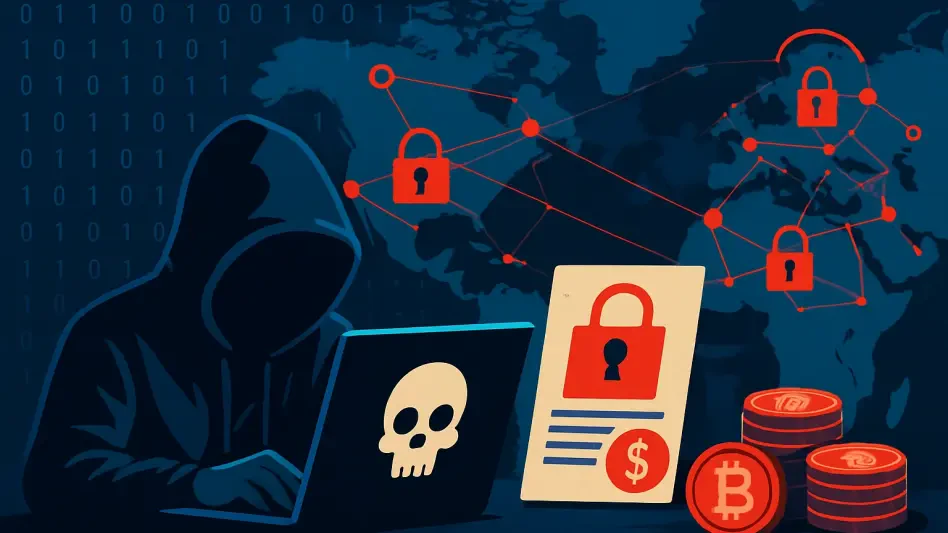Ransomware attacks, a prominent form of cybercrime, have been evolving rapidly and are seen as potential tools in the broader spectrum of cyber warfare. While the number of ransomware incidents saw a sharp decline of nearly half in the second quarter of 2025, the threat remains potent and pervasive. The reduction in attack volumes is not indicative of a reduced threat but rather reflects adaptive shifts among attackers and strategic countermeasures by global law enforcement agencies. As geopolitics continue to influence cyber strategies, states and non-state actors alike are integrating ransomware into their arsenals, targeting vulnerable sectors with relentless precision.
The Changing Landscape of Ransomware
Factors Behind the Decline in Attacks
In 2025, the landscape of ransomware attacks experienced nuanced fluctuations, with a notable global decline in their frequency. This decrease, rooted in various temporal and external factors, can be misleading if viewed merely as a reduction in threat levels. Observations reveal that this trend may be attributed to several elements, such as global holidays like Easter and Ramadan, which traditionally slow business activities and subsequently affect criminal operations temporarily. Concurrently, enhanced focus by international law enforcement agencies in thwarting key ransomware groups has contributed significantly to this phenomenon. Increased collaboration between countries in cyber defense efforts and technological advancements in threat detection have played pivotal roles in disrupting illicit cyber activities. This multifaceted response underscores the global nature of the threat and the necessity for international cooperation.
Emerging Threat Actors and Geopolitical Tensions
Despite the temporary lull in activity, newly emerging threat actors are capitalizing on geopolitical tensions, amplifying the pervasive threat ransomware poses. These nascent groups exploit areas of unrest and political instability to assert their influence, effectively merging cybercrime with cyber warfare tactics. A prime illustration of this is evident in politically motivated groups that target state institutions to convey political messages or disrupt governmental operations. Such incidents highlight an unsettling trend of ransomware being leveraged beyond mere financial extortion. Observers are keenly aware that geopolitical rivalries now play a defining role in the strategy matrix of cybercriminals, leading to an intricate intertwining of cybercrime with statecraft. With nation-states increasingly involved either directly or tangentially in cyber campaigns, ransomware assumes an ominous dual role.
Impact Across Industries and Global Reach
Sectors Bearing the Brunt
The reach of ransomware is broad, with different sectors experiencing varying levels of targeted attacks. Industries such as industrials have become favored targets due to their vast networks and integration within critical infrastructure, representing nearly 27% of all reported cases. The sheer operational significance of this sector and rich datasets make it an appealing target for attackers aiming to disrupt or extort. Meanwhile, the consumer discretionary sector, including retail, reported a downward trend in attacks, coinciding with reduced activities from groups like Scattered Spider. Nevertheless, healthcare and information technology sectors continue to endure increasing pressure, highlighting their attractiveness due to the sensitive and high-value nature of stored data. The contrast between sectors underscores the adaptable nature of attackers, capable of shifting targets to exploit vulnerabilities.
Geographical Concentrations of Ransomware Activity
Ransomware’s geographical impact has been particularly stark, with North America facing the brunt of attacks. This region accounted for a staggering 58% of all incidents worldwide in June 2025, reflecting its vulnerabilities amid swift digital transformation and vast economic incentives for attackers. The continent’s substantial share of cyber attacks has prompted vigorous mitigation strategies and has drawn attention to persistent security challenges. Meanwhile, Europe experienced a slight decline in incidents, responsible for 21% of global cases, suggesting varying threats across regions. Recent data also indicate that Asia and South America have encountered lower, yet significant, attack volumes, symbolizing a strategic distribution by ransomware operatives. The diversified geographical distribution of these cyber threats underscores the need for tailored cybersecurity strategies at both regional and national levels.
The Role of Ransomware in Modern Geopolitics
Political Messaging and Ransomware’s Dual Use
Ransomware has emerged as a versatile tool for both economic gain and political influence, permeating traditional boundaries in cyber operations. A profound example involves the Handala group, which utilized ransomware attacks in tandem with geopolitical tensions, targeting Israeli organizations amid escalating Iran-Israel conflicts. Such strategic deployments mark the tactic’s evolution from solely a financial weapon to one instrumental in political scenarios, signifying a broader utility. This shift reveals the increasing sophistication of ransomware operations, where attackers divest from typical malicious practices to embrace complex, multifaceted strategies. The integration of ransomware into political agendas underlines its growing role as a potent tool of power projection, exacerbating concerns about its dual-use capabilities in the evolving landscape of cyber warfare.
National Strategies and Countermeasures
Governments worldwide are now realigning their cyber defense strategies in response to the escalating threat of ransomware as a cyber warfare tool. Legislation, public-private partnerships, and international collaborations form the bedrock of these renewed strategies. For instance, the British government’s launch of an industrial strategy highlights a commitment to shielding national sectors from increasing cyber threats, reflecting a proactive approach to cyber resilience. Countries are recognizing cybersecurity as an indispensable component of national defense, emphasizing the importance of intelligence sharing and coordinated response to counteract sophisticated threats. The very nature of cyber warfare, with its rapid evolution and capability for covert operations, necessitates a continuous and adaptive national strategy to ensure comprehensive security postures.
Path Ahead in Ransomware Threat Mitigation
Ransomware attacks, a notable form of cybercrime, have been advancing swiftly and are now regarded as potential tools in the expansive field of cyber warfare. While the number of ransomware incidents experienced a significant drop of nearly 50% in the second quarter of 2025, the danger posed by these attacks remains substantial and widespread. This decline in the frequency of incidents does not signify a decrease in threat level. Instead, it signals a shift in the tactics used by attackers, as well as strategic measures implemented by international law enforcement agencies. As geopolitical tensions continue to shape cyber strategy, both state and non-state entities increasingly incorporate ransomware into their tactical repertoire, aiming with unyielding precision at sectors that are especially prone to attack. This evolving landscape underscores the persistent threat posed by ransomware, which is adapted continuously by cybercriminals across the globe to exploit weaknesses in both public and private sectors.








